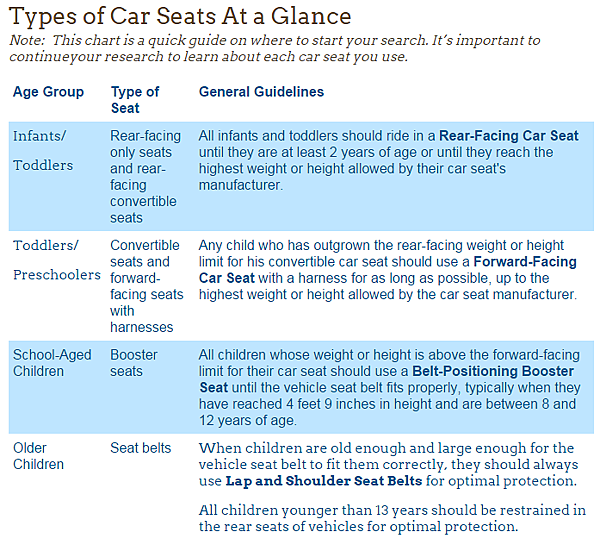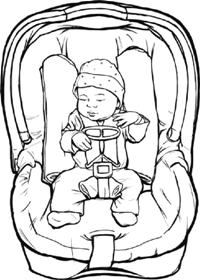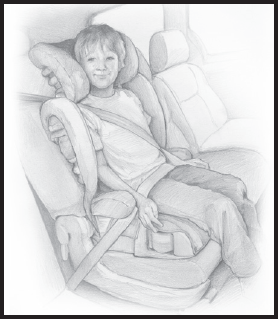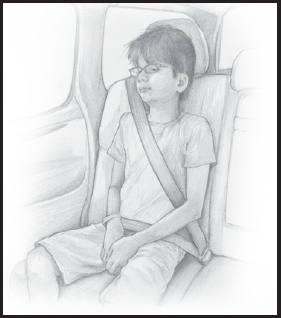(20150712 update:感謝網友指正錯誤,刪除了關於太晚從提籃換至成長型座椅的評論,並加入後向安全座椅使用注意)
因為X媽事件讓我的FB版上短時間久多了不少安全座椅的討論文
但看到幾篇被大量轉錄的文章資訊都過時
又想起這幾年在美國看到遇到甚至自己犯過的使用錯誤
決定來分享這篇美國小兒醫學會2015年兒童汽車安全座椅指引
原文 Car Seats: Information for Families for 2015 (from health children.org)
https://www.healthychildren.org/English/safety-prevention/on-the-go/Pages/Car-Safety-Seats-Information-for-Families.aspx

(表格取自原文網站,後續有重點節錄翻譯。翻譯僅供參考,請以原文為依據)
Infants & Toddlers: Rear-Facing 嬰幼兒:要朝向車尾(安全座椅要後向安裝)
The AAP recommends that all infants should ride rear- facing starting with their first ride home from the hospital. All infants and toddlers should ride in a rear-facing car seat until they are at least 2 years of age or preferably until they reach the highest weight or height allowed by their car seat’s manufacturer.
美國小兒醫學會建議所有嬰兒從出院第一次坐車回家開始應該就應該坐在後向安裝的汽車座椅上,並維持後向直到至少兩歲或超過安全座椅的後向使用身高/體重上限。
There are 3 types of rear-facing car seats: rear-facing only seats, convertible seats, and 3-in-1 seats.
When children reach the highest weight or length allowed by the manufacturer of their rear-facing only seat, they should continue to ride rear-facing in a convertible seat or 3-in-1 seat.
有三種型式的後向安全座椅:只能後向的嬰兒提籃、可前向後向安裝的成長型汽座及三合一汽座
當幼兒的身高或體重超過嬰兒提籃的身高/體重上限時,小孩應該換至成長型或三合一汽座但繼續面向車尾。
When using a rear-facing seat, keep the following in mind: 使用後向安全座椅時需注意
Place the harnesses in your rear-facing seat in slots that are at or below your baby's shoulders.
使用與寶寶肩膀同高或較寶寶肩膀略低的肩帶出口。
Ensure that the harness is snug and that the harness clip is placed at the center of the chest and at the level of the child’s armpits.
確定肩帶是服貼的且胸扣位於寶寶的胸口,與腋窩同高
Make sure the car seat is installed tightly in the vehicle. If you can move the seat at the belt path more than an inch side to side or front to back, it's not tight enough.
確定固定安全座椅的安全帶拉得夠緊,當你左右搖晃安全座椅時,座椅不會移動超過1英吋。
Never place a rear-facing car seat in the front seat of a vehicle that has an active front passenger air bag. If the air bag inflates, it will hit the back of the car seat, right where your baby's head is, and could cause serious injury or death.
絕對不要將後向安全座椅安裝在安全氣囊裝置啟動中的副駕使座。當安全氣囊因撞擊而充氣時,氣囊會撞到寶寶的頭而造成寶寶受傷甚至死亡。
Common Questions About Rear-Facing Car Seats 後向汽座常見問題
What if my baby's feet touch the back of the vehicle seat?
Your child can bend his legs easily and will be comfortable in a rear-facing seat. Injuries to the legs are rare for children facing the rear.
如果我家寶寶的腳踢到車椅了呢?
小孩可以輕鬆地把膝蓋彎曲並在汽座上找到他覺得舒服的姿勢。因後向而造成腿部傷害並不常見。
What do I do if my baby slouches down or to the side in his car seat?
Blanket rolls may be placed on both sides of the infant and a small diaper or blanket between the crotch strap and the infant. Do not place padding under or behind the infant or use any sort of car seat insert unless it came with the seat or was made by the manufacturer of the seat.
寶寶會滑向側邊怎麼辦?
可用毛巾捲幫助固定寶寶。不要使用非原廠提供且要加裝在寶寶背部或下方的墊子。(見圖)

Why should I dress my baby in thinner layers of clothing before strapping her into a car seat?
Bulky clothing, including winter coats and snowsuits, can compress in a crash and lead to increased risk of injury. Ideally, dress your baby in thinner layers and tuck a coat or a blanket around your baby over the buckled harness straps if needed.
為什麼要在放入汽座前為寶寶脫去厚外衣?
冬天的厚外套或雪衣這樣厚重的衣物在車禍時會造成壓迫及導致傷害風險的增加。將外套或毛毯蓋在安全帶上方並將邊角塞住以固定避免窒息較為理想。
兩歲以下的嬰幼兒重點就是要把安全座椅朝向車尾,才能在車禍時有效保護寶寶的脊椎。
(網路上有慘痛的經驗分享,有興趣的朋友自行google吧)
這是我看到網路資訊中最常遺漏的,而太早將寶寶轉成前向也是我看過最常犯的汽座錯誤。
美國小兒醫學會在2011年才將後向建議延長到2歲,所以黃瑽寧醫生在2009年寫的文章中是寫一歲就可以換成前向。
事實上,我自己也差點就在迷你鯨一歲後就轉成前向。幸好我的小兒科醫師在一歲健檢時再三強調要等到至少兩歲才能轉到前向。
當時我也有問說寶寶一直在踢後座椅不會不舒服或影響發育嗎?醫生只是酷酷說就讓他踢,他會找他自己舒服的姿勢。
也真的迷你鯨越長越高,到快兩歲時不是半盤著腿就是抬得老高,似乎也不覺得有什麼困擾。
訪問身邊在一歲後就轉前向的爸媽朋友,原因都和安全無關,而是情緒問題。
即使是從出生就坐汽座的美國小孩(包括迷你鯨),到9個月~1歲初幾乎都會出現反抗汽座討厭安全帶的時期。
這時為了方便安撫小孩及看到小孩在後座的行為,尤其是常常需要獨自開車載小孩的父母,就會提早轉為前向。
雖然AAP在2011年提出新指引,但還沒列入州法,也不是每個小兒科醫生都認同或會提醒家長這個新指引。
我甚至有遇過寶寶才過前向體重下限(不是後向的上限)就轉向的父母,必須說這是非常冒險的行為。
也許我們都是小心守法的駕駛人,但路上瘋子太多,多等一年是值得的。
迷你鯨的汽座反抗期直到近一歲半才好轉,唯一慶幸的是我家一直是大鯨開車。
我雖然是易暈車的體質,但為了行車安全從他出生就一直坐後座,隨時可以應付他安撫他。
真的暈到不行時也就任他哭鬧直到停車點才抱起。
7個多月時回台灣曾偷懶(加上長輩的不以為然)用抱的,才5分鐘的車程我抱到手心冒冷汗。
真的不要拿小孩的生命去賭。
Toddlers & Preschoolers: Forward-Facing 幼兒和學齡前幼童:使用前向附有安全帶的汽座
Any child who has outgrown the rear-facing weight or height limit for their convertible car seat should use a forward-facing car seat with a harness for as long as possible, up to the highest weight or height allowed by their car seat manufacturer. It is best for children to ride in a seat with a harness as long as possible, at least to 4 years of age. If your child out-grows his seat before reaching 4 years of age, consider using a seat with a harness approved for higher weights and heights.
當幼童的身高或體重超過成長型汽座的上限時,應改用附有安全帶的前向型汽座直到至少四歲。若你的小孩在四歲前超過現有汽座的上限,請考慮能承受更高或更重的附安全帶汽座。
Common Questions About Foward-Facing Car Seats 前向汽座的常見疑問
What if I drive more children than can be buckled safely in the back seat?
It's best to avoid this, especially if your vehicle has air bags in the front seat. All children younger than 13 years should ride in the back seat. If absolutely necessary, a child in a forward-facing car seat with a harness may be the best choice to ride in front. Just be sure the vehicle seat is moved as far back away from the dashboard (and the air bag) as possible.
如果我需要載的小孩數超過後座的安全扣或汽座安裝上限怎麼辦?
最好避免這種情況,尤其當你的車子有前座安全氣囊時。所有13歲以下的小孩都應坐在後座。如果絕對必要使用前座載兒童,附有安全帶的前向汽座也許是最好的選擇,且務必將椅子後推遠離安全氣囊。
四歲前幼童的重點在要使用附安全帶的汽座,不要太早換成使用車上安全帶的增高椅。
現在很多增高椅都是2合1的,有附安全帶的椅背,也可在小孩4歲或更大之後,轉變成一般的增高椅。
對於較早超過成長型汽座的小孩是比較經濟又安全的選擇。
另外因為美國生超過2個的家庭不少,有時又會幫鄰居接小孩,就會出現後座安全帶/汽座不夠放的情況。
AAP建議13歲以下兒童不得坐前座(很多州法也有差不多的規定)。
美國家庭很常有一台7人座以上的車,但我就遇過台灣朋友讓5歲的小孩坐前座的情況。
所有前座有安全氣囊的的車子都會在前座貼上警告不要安裝汽座在前座,但即使沒有汽座,安全氣囊還是有讓小孩窒息的危險。
School-Aged Children: Booster Seats 學齡兒童:使用增高椅
Booster seats are for older children who have outgrown their forward-facing car seats. All children whose weight or height is above the forward-facing limit for their car seat should use a belt-positioning booster seat until the vehicle seat belt fits properly, typically when they have reached 4 feet 9 inches in height and are between 8 and 12 years of age. The owner's manual that comes with your car seat will tell you the height and weight limits for the seat. As a general guideline, a child has outgrown his forward-facing seat when any one of the following is true:
He reaches the top weight or height allowed for his seat with a harness. (These limits are listed on the seat and also included in the instruction booklet.)
His shoulders are above the top harness slots.
His ears have reached the top of the seat.
當兒童超過前向汽座的使用上限時,應改用增高椅直到兒童身高超過4呎9吋(145公分)能安全地使用車上安全帶。
判別兒童是否需要換成增高椅的依據有三:
兒童的身高或體重超過前向汽座的使用上限。
兒童的肩膀高於前向汽座最高的肩帶口。(一般汽座都會有複數個肩帶口讓家長隨小孩成長調整肩帶位置和長度)
兒童的耳朵碰到汽座的上緣。

Older Children: Seat Belts 較年長的兒童:車上安全帶
Seat belts are made for adults. Your child should stay in a booster seat until adult seat belts fit correctly (usually when the child reaches about 4 feet 9 inches in height and is between 8 and 12 years of age). When children are old enough and large enough to use the vehicle seat belt alone, they should always use lap and shoulder seat belts for optimal protection.
車上的安全帶是以成人的身高設計的。兒童在高度足夠安全使用車上安全帶前都應坐在增高椅上,以確保安全帶在跨在正確的位置上。兒童乘車時應全程扣上肩膝部安全帶。

Using a Seat Belt 使用車上安全帶的要點
An adult seat belt fits correctly when:
The shoulder belt lies across the middle of the chest and shoulder, not the neck or throat.
The lap belt is low and snug across the upper thighs, not the belly.
Your child is tall enough to sit against the vehicle seat back with her knees bent comfortably over the edge of the seat without slouching and can stay in this position comfortably throughout the trip.
Other points to keep in mind when using seat belts include:
Make sure your child does not tuck the shoulder belt under her arm or behind her back. This leaves the upper body unprotected and adds extra slack into the seat belt system, putting your child at risk of severe injury in a crash or with sudden braking.
Never allow anyone to "share" seat belts. All passengers must have their own car safety seats or seat belts.
車上安全帶安全使用時,肩帶應從肩帶斜跨過胸口,而不是跨過頸部。膝帶要跨在大腿上,而不是肚子上。
兒童要夠高到可在膝蓋自然彎曲時靠坐在椅背上,且全程維持坐姿不會覺得不適。
請確定肩帶沒被兒童塞在手臂下方或背後,這樣會讓兒童的上半身不在安全帶的保護範圍內而在車禍或緊急煞車時增加受傷的風險和嚴重度。
絕對不要允許共用安全帶的行為。每個乘客都要有自己的汽座或安全帶。
Important Reminders 重要提醒
Be a good role model. Make sure you always wear your seat belt. This will help your child form a lifelong habit of buckling up.
以身作則。每次上車就扣上安全帶,這會幫助你的小孩養成使用安全帶的好習慣。
Make sure that everyone who transports your child uses the correct car seat or seat belt on every trip, every time. Being consistent with car seat use is good parenting, reduces fussing and complaints, and is safest for your child.
持之以恆。確保小孩每次乘車都使用正確的汽座或安全帶,對汽座及安全帶一致性的使用要求可減少小孩對汽座或安全帶的反感並增加行車的安全。
Never leave your child alone in or around cars. Any of the following can happen when a child is left alone in or around a vehicle. A child can:
Die of heat stroke because temperatures can reach deadly levels in minutes.
Be strangled by power windows, retracting seat belts, sunroofs, or accessories.
Knock the vehicle into gear, setting it in motion.
Be backed over when the vehicle backs up.
Become trapped in the trunk of the vehicle.
絕對不要把小孩單獨留在車上或車邊。小孩可能因溫度過高而死亡或休克,也可能被車窗或天窗夾傷。或是被倒退的車輛撞倒或困在後車廂,甚至自行發動車輛等。
Always read and follow the manufacturer's instructions. If you do not have the manufacturer's instructions for your car seat, write or call the company's customer service department. They will ask you for the model number, name of seat, and date of manufacture. The manufacturer's address and phone number are on a label on the seat. Also be sure to follow the instructions in your vehicle owner's manual about using car seats. Some manufacturers' instructions may be available on their Web sites.
務必閱讀車子的使用說明,並遵照使用說明駕駛及維護車輛。
(翻譯僅供資訊交流,歡迎指正錯誤,但請以原文為依據。)
因為X媽事件讓我的FB版上短時間久多了不少安全座椅的討論文
但看到幾篇被大量轉錄的文章資訊都過時
又想起這幾年在美國看到遇到甚至自己犯過的使用錯誤
決定來分享這篇美國小兒醫學會2015年兒童汽車安全座椅指引
原文 Car Seats: Information for Families for 2015 (from health children.org)
https://www.healthychildren.org/English/safety-prevention/on-the-go/Pages/Car-Safety-Seats-Information-for-Families.aspx

(表格取自原文網站,後續有重點節錄翻譯。翻譯僅供參考,請以原文為依據)
Infants & Toddlers: Rear-Facing 嬰幼兒:要朝向車尾(安全座椅要後向安裝)
The AAP recommends that all infants should ride rear- facing starting with their first ride home from the hospital. All infants and toddlers should ride in a rear-facing car seat until they are at least 2 years of age or preferably until they reach the highest weight or height allowed by their car seat’s manufacturer.
美國小兒醫學會建議所有嬰兒從出院第一次坐車回家開始應該就應該坐在後向安裝的汽車座椅上,並維持後向直到至少兩歲或超過安全座椅的後向使用身高/體重上限。
There are 3 types of rear-facing car seats: rear-facing only seats, convertible seats, and 3-in-1 seats.
When children reach the highest weight or length allowed by the manufacturer of their rear-facing only seat, they should continue to ride rear-facing in a convertible seat or 3-in-1 seat.
有三種型式的後向安全座椅:只能後向的嬰兒提籃、可前向後向安裝的成長型汽座及三合一汽座
當幼兒的身高或體重超過嬰兒提籃的身高/體重上限時,小孩應該換至成長型或三合一汽座但繼續面向車尾。
When using a rear-facing seat, keep the following in mind: 使用後向安全座椅時需注意
Place the harnesses in your rear-facing seat in slots that are at or below your baby's shoulders.
使用與寶寶肩膀同高或較寶寶肩膀略低的肩帶出口。
Ensure that the harness is snug and that the harness clip is placed at the center of the chest and at the level of the child’s armpits.
確定肩帶是服貼的且胸扣位於寶寶的胸口,與腋窩同高
Make sure the car seat is installed tightly in the vehicle. If you can move the seat at the belt path more than an inch side to side or front to back, it's not tight enough.
確定固定安全座椅的安全帶拉得夠緊,當你左右搖晃安全座椅時,座椅不會移動超過1英吋。
Never place a rear-facing car seat in the front seat of a vehicle that has an active front passenger air bag. If the air bag inflates, it will hit the back of the car seat, right where your baby's head is, and could cause serious injury or death.
絕對不要將後向安全座椅安裝在安全氣囊裝置啟動中的副駕使座。當安全氣囊因撞擊而充氣時,氣囊會撞到寶寶的頭而造成寶寶受傷甚至死亡。
Common Questions About Rear-Facing Car Seats 後向汽座常見問題
What if my baby's feet touch the back of the vehicle seat?
Your child can bend his legs easily and will be comfortable in a rear-facing seat. Injuries to the legs are rare for children facing the rear.
如果我家寶寶的腳踢到車椅了呢?
小孩可以輕鬆地把膝蓋彎曲並在汽座上找到他覺得舒服的姿勢。因後向而造成腿部傷害並不常見。
What do I do if my baby slouches down or to the side in his car seat?
Blanket rolls may be placed on both sides of the infant and a small diaper or blanket between the crotch strap and the infant. Do not place padding under or behind the infant or use any sort of car seat insert unless it came with the seat or was made by the manufacturer of the seat.
寶寶會滑向側邊怎麼辦?
可用毛巾捲幫助固定寶寶。不要使用非原廠提供且要加裝在寶寶背部或下方的墊子。(見圖)

Why should I dress my baby in thinner layers of clothing before strapping her into a car seat?
Bulky clothing, including winter coats and snowsuits, can compress in a crash and lead to increased risk of injury. Ideally, dress your baby in thinner layers and tuck a coat or a blanket around your baby over the buckled harness straps if needed.
為什麼要在放入汽座前為寶寶脫去厚外衣?
冬天的厚外套或雪衣這樣厚重的衣物在車禍時會造成壓迫及導致傷害風險的增加。將外套或毛毯蓋在安全帶上方並將邊角塞住以固定避免窒息較為理想。
兩歲以下的嬰幼兒重點就是要把安全座椅朝向車尾,才能在車禍時有效保護寶寶的脊椎。
(網路上有慘痛的經驗分享,有興趣的朋友自行google吧)
這是我看到網路資訊中最常遺漏的,而太早將寶寶轉成前向也是我看過最常犯的汽座錯誤。
美國小兒醫學會在2011年才將後向建議延長到2歲,所以黃瑽寧醫生在2009年寫的文章中是寫一歲就可以換成前向。
事實上,我自己也差點就在迷你鯨一歲後就轉成前向。幸好我的小兒科醫師在一歲健檢時再三強調要等到至少兩歲才能轉到前向。
當時我也有問說寶寶一直在踢後座椅不會不舒服或影響發育嗎?醫生只是酷酷說就讓他踢,他會找他自己舒服的姿勢。
也真的迷你鯨越長越高,到快兩歲時不是半盤著腿就是抬得老高,似乎也不覺得有什麼困擾。
訪問身邊在一歲後就轉前向的爸媽朋友,原因都和安全無關,而是情緒問題。
即使是從出生就坐汽座的美國小孩(包括迷你鯨),到9個月~1歲初幾乎都會出現反抗汽座討厭安全帶的時期。
這時為了方便安撫小孩及看到小孩在後座的行為,尤其是常常需要獨自開車載小孩的父母,就會提早轉為前向。
雖然AAP在2011年提出新指引,但還沒列入州法,也不是每個小兒科醫生都認同或會提醒家長這個新指引。
我甚至有遇過寶寶才過前向體重下限(不是後向的上限)就轉向的父母,必須說這是非常冒險的行為。
也許我們都是小心守法的駕駛人,但路上瘋子太多,多等一年是值得的。
迷你鯨的汽座反抗期直到近一歲半才好轉,唯一慶幸的是我家一直是大鯨開車。
我雖然是易暈車的體質,但為了行車安全從他出生就一直坐後座,隨時可以應付他安撫他。
真的暈到不行時也就任他哭鬧直到停車點才抱起。
7個多月時回台灣曾偷懶(加上長輩的不以為然)用抱的,才5分鐘的車程我抱到手心冒冷汗。
真的不要拿小孩的生命去賭。
Toddlers & Preschoolers: Forward-Facing 幼兒和學齡前幼童:使用前向附有安全帶的汽座
Any child who has outgrown the rear-facing weight or height limit for their convertible car seat should use a forward-facing car seat with a harness for as long as possible, up to the highest weight or height allowed by their car seat manufacturer. It is best for children to ride in a seat with a harness as long as possible, at least to 4 years of age. If your child out-grows his seat before reaching 4 years of age, consider using a seat with a harness approved for higher weights and heights.
當幼童的身高或體重超過成長型汽座的上限時,應改用附有安全帶的前向型汽座直到至少四歲。若你的小孩在四歲前超過現有汽座的上限,請考慮能承受更高或更重的附安全帶汽座。
Common Questions About Foward-Facing Car Seats 前向汽座的常見疑問
What if I drive more children than can be buckled safely in the back seat?
It's best to avoid this, especially if your vehicle has air bags in the front seat. All children younger than 13 years should ride in the back seat. If absolutely necessary, a child in a forward-facing car seat with a harness may be the best choice to ride in front. Just be sure the vehicle seat is moved as far back away from the dashboard (and the air bag) as possible.
如果我需要載的小孩數超過後座的安全扣或汽座安裝上限怎麼辦?
最好避免這種情況,尤其當你的車子有前座安全氣囊時。所有13歲以下的小孩都應坐在後座。如果絕對必要使用前座載兒童,附有安全帶的前向汽座也許是最好的選擇,且務必將椅子後推遠離安全氣囊。
四歲前幼童的重點在要使用附安全帶的汽座,不要太早換成使用車上安全帶的增高椅。
現在很多增高椅都是2合1的,有附安全帶的椅背,也可在小孩4歲或更大之後,轉變成一般的增高椅。
對於較早超過成長型汽座的小孩是比較經濟又安全的選擇。
另外因為美國生超過2個的家庭不少,有時又會幫鄰居接小孩,就會出現後座安全帶/汽座不夠放的情況。
AAP建議13歲以下兒童不得坐前座(很多州法也有差不多的規定)。
美國家庭很常有一台7人座以上的車,但我就遇過台灣朋友讓5歲的小孩坐前座的情況。
所有前座有安全氣囊的的車子都會在前座貼上警告不要安裝汽座在前座,但即使沒有汽座,安全氣囊還是有讓小孩窒息的危險。
School-Aged Children: Booster Seats 學齡兒童:使用增高椅
Booster seats are for older children who have outgrown their forward-facing car seats. All children whose weight or height is above the forward-facing limit for their car seat should use a belt-positioning booster seat until the vehicle seat belt fits properly, typically when they have reached 4 feet 9 inches in height and are between 8 and 12 years of age. The owner's manual that comes with your car seat will tell you the height and weight limits for the seat. As a general guideline, a child has outgrown his forward-facing seat when any one of the following is true:
He reaches the top weight or height allowed for his seat with a harness. (These limits are listed on the seat and also included in the instruction booklet.)
His shoulders are above the top harness slots.
His ears have reached the top of the seat.
當兒童超過前向汽座的使用上限時,應改用增高椅直到兒童身高超過4呎9吋(145公分)能安全地使用車上安全帶。
判別兒童是否需要換成增高椅的依據有三:
兒童的身高或體重超過前向汽座的使用上限。
兒童的肩膀高於前向汽座最高的肩帶口。(一般汽座都會有複數個肩帶口讓家長隨小孩成長調整肩帶位置和長度)
兒童的耳朵碰到汽座的上緣。

Older Children: Seat Belts 較年長的兒童:車上安全帶
Seat belts are made for adults. Your child should stay in a booster seat until adult seat belts fit correctly (usually when the child reaches about 4 feet 9 inches in height and is between 8 and 12 years of age). When children are old enough and large enough to use the vehicle seat belt alone, they should always use lap and shoulder seat belts for optimal protection.
車上的安全帶是以成人的身高設計的。兒童在高度足夠安全使用車上安全帶前都應坐在增高椅上,以確保安全帶在跨在正確的位置上。兒童乘車時應全程扣上肩膝部安全帶。

Using a Seat Belt 使用車上安全帶的要點
An adult seat belt fits correctly when:
The shoulder belt lies across the middle of the chest and shoulder, not the neck or throat.
The lap belt is low and snug across the upper thighs, not the belly.
Your child is tall enough to sit against the vehicle seat back with her knees bent comfortably over the edge of the seat without slouching and can stay in this position comfortably throughout the trip.
Other points to keep in mind when using seat belts include:
Make sure your child does not tuck the shoulder belt under her arm or behind her back. This leaves the upper body unprotected and adds extra slack into the seat belt system, putting your child at risk of severe injury in a crash or with sudden braking.
Never allow anyone to "share" seat belts. All passengers must have their own car safety seats or seat belts.
車上安全帶安全使用時,肩帶應從肩帶斜跨過胸口,而不是跨過頸部。膝帶要跨在大腿上,而不是肚子上。
兒童要夠高到可在膝蓋自然彎曲時靠坐在椅背上,且全程維持坐姿不會覺得不適。
請確定肩帶沒被兒童塞在手臂下方或背後,這樣會讓兒童的上半身不在安全帶的保護範圍內而在車禍或緊急煞車時增加受傷的風險和嚴重度。
絕對不要允許共用安全帶的行為。每個乘客都要有自己的汽座或安全帶。
Important Reminders 重要提醒
Be a good role model. Make sure you always wear your seat belt. This will help your child form a lifelong habit of buckling up.
以身作則。每次上車就扣上安全帶,這會幫助你的小孩養成使用安全帶的好習慣。
Make sure that everyone who transports your child uses the correct car seat or seat belt on every trip, every time. Being consistent with car seat use is good parenting, reduces fussing and complaints, and is safest for your child.
持之以恆。確保小孩每次乘車都使用正確的汽座或安全帶,對汽座及安全帶一致性的使用要求可減少小孩對汽座或安全帶的反感並增加行車的安全。
Never leave your child alone in or around cars. Any of the following can happen when a child is left alone in or around a vehicle. A child can:
Die of heat stroke because temperatures can reach deadly levels in minutes.
Be strangled by power windows, retracting seat belts, sunroofs, or accessories.
Knock the vehicle into gear, setting it in motion.
Be backed over when the vehicle backs up.
Become trapped in the trunk of the vehicle.
絕對不要把小孩單獨留在車上或車邊。小孩可能因溫度過高而死亡或休克,也可能被車窗或天窗夾傷。或是被倒退的車輛撞倒或困在後車廂,甚至自行發動車輛等。
Always read and follow the manufacturer's instructions. If you do not have the manufacturer's instructions for your car seat, write or call the company's customer service department. They will ask you for the model number, name of seat, and date of manufacture. The manufacturer's address and phone number are on a label on the seat. Also be sure to follow the instructions in your vehicle owner's manual about using car seats. Some manufacturers' instructions may be available on their Web sites.
務必閱讀車子的使用說明,並遵照使用說明駕駛及維護車輛。
(翻譯僅供資訊交流,歡迎指正錯誤,但請以原文為依據。)
全站熱搜


 留言列表
留言列表